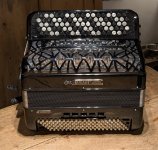Justin L
Newbie
Hello everyone, first post here! I'm a newer chromatic C system player here in Texas. I have a Weltmeister 703 (3 bass registers, 5 Treble) it's a good accordion but I've already got the upgrade bug going. Is upgrading to a better accordion going to make much of a difference in the sound I'm producing? (I know it won't make me a better player.) I'd be looking at going to something like one of the below around that $4500 range.
Liberty Bellows - Scandalli AIR IC
Liberty Bellows - Black Beltuna Studio III
Petosa - Americana C39
Carnegie - Bugari 320
Reverb - Used Bugari Armando Champion Cassotto
I'd love to go in person, try stuff out, bring in my Weltmeister test it out against other accordions. But just making the trip alone has costs, also being a Chromatic player there's not a store that has a lot of options here in the US (Maybe Liberty Bellows).
Anyways what do yall think? Should I just sit tight with the Weltmeister as it's not much of a difference compared to the above accordions? Any of the accordions listed above stand out either in a positive or negative way?
Thanks for any advice!
Liberty Bellows - Scandalli AIR IC
Liberty Bellows - Black Beltuna Studio III
Petosa - Americana C39
Carnegie - Bugari 320
Reverb - Used Bugari Armando Champion Cassotto
I'd love to go in person, try stuff out, bring in my Weltmeister test it out against other accordions. But just making the trip alone has costs, also being a Chromatic player there's not a store that has a lot of options here in the US (Maybe Liberty Bellows).
Anyways what do yall think? Should I just sit tight with the Weltmeister as it's not much of a difference compared to the above accordions? Any of the accordions listed above stand out either in a positive or negative way?
Thanks for any advice!

